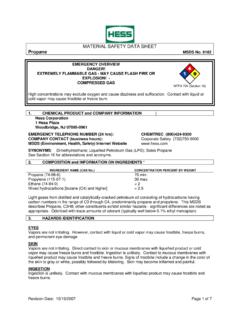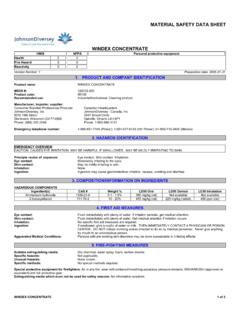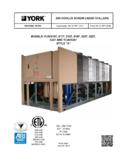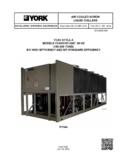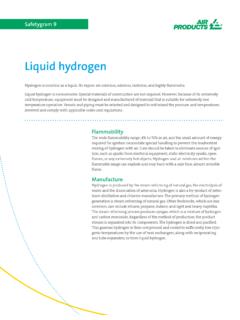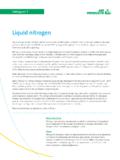Transcription of 1. CHEMICAL PRODUCT AND COMPANY …
1 MATERIAL SAFETY DATA SHEET 28-00-00. AGRISOLUTIONS liquid Fertilizer For CHEMICAL Emergency, Spill, Leak, Fire, Exposure or Accident, CALL CHEMTREC Day or Night 1-800-424-9300 or 1-800-228-5635. 1. CHEMICAL PRODUCT AND COMPANY IDENTIFICATION. PRODUCT Name: 28-00-00 liquid Fertilizer Synonyms: 28% UAN. COMPANY ID: Agriliance, LLC. PO Box 64089. St. Paul, MN 55164-0089. Phone #s: Emergency Phone Number - CHEMTREC (day or night): 1-800-424-9300. For Medical Emergency - Call 1-877-424-7452. Date: 07/01/03 Supersedes: New 2. COMPOSITION INFORMATION ON INGREDIENTS. Component CAS Reg. No. %. Ammonium nitrate 6484-52-2 Urea 57-13-6 Water 7732-18-5 Typical N-P-K Composition Total Nitrogen as N 28%.
2 Total Phosphorus as P205 0%. Total Potassium 0%. Fertilizer salts, inert ingredients 72%. See Section 8 for Personal Protection Limits (PPE). 3. HAZARDS IDENTIFICATION. Emergency Overview: Appearance & Odor: Colorless solution, with slight fertilizer odor. Warning Statements: This is a liquid fertilizer PRODUCT and we should avoid extreme temperatures. Not generally harmful if swallowed, ingestion of large amounts may cause systemic ammonia poisoning and nitrate poisoning. May cause aggravation of the eyes. May cause local discomfort if skin with cuts is exposed. Potential Adverse Health Effects: Eye Contact: May cause eye aggravation.
3 Skin Contact: Not absorbed through the skin. Ingestion: Not generally considered hazardous. Ingestion of large amounts may cause ammonia and/or nitrate poisoning. Inhalation: Low problem under normal conditions, if difficulty in breathing, remove to fresh air. Effects of overdose: Ingestion of large amounts may cause dizziness, abdominal cramps, vomiting and diarrhea and discomfort to skin and eyes. 4. FIRST AID MEASURES. If in Eyes: Flush with cool water for 15 minutes. Remove contact lenses, if applicable and continue flushing for 15 minutes. Hold eyelids apart to rinse the entire surface of the eyes and lids.
4 Seek medical attention if irritation persists. If on Skin: Wash skin with soap and water. Obtain medical attention if irritation persists. Page 1 of 4. MATERIAL SAFETY DATA SHEET 28-00-00. AGRISOLUTIONS liquid Fertilizer If Swallowed: Induce vomiting after the victim drinks 1 to 2 glasses of water. Never give anything to a person who is unconscious. Obtain medical attention. If Inhaled: Remove to fresh air. If not breathing, call 9-1-1 and provide mouth-to-mouth resuscitation. Seek medical help if breathing is difficult. 5. FIRE FIGHTING MEASURES. Flash Point: Non-flammable. Flammable Limits: Not established.
5 Extinguishing Media: Considered non-combustible, use medium appropriate to surrounding fire, water spray or fog, foam, carbon dioxide or dry CHEMICAL . Special Fire Fighting Procedures: None in liquid state. Organic and oxidizable materials can sensitize dry ammonium nitrate to a readily explodable state; can detonate if heated under confinement with high pressure. Provide for the protection of the employees and residents: Notify local authorities that firemen should wear self-contained breathing apparatus with full protecting clothing, be immediately relieved from duty, if exposed to contaminated smoke which may include and are not limited to oxides of nitrogen and carbon; and ammonia when heated to decomposition.
6 See section 11 for toxicological data. 6. ACCIDENTAL RELEASE MEASURES. In Case of Spill or Leak Prevent entry into sewer or waterways. For small spills, absorb in sand or kitty litter or other absorbent, then sweep up and use as a fertilizer by applying to soil using good agricultural and soil management. For large spill on roadside, avoid contamination of water ways as this liquid fertilizer will increase algae formation, use diking to keep the spill in the ditch. Use loader to remove fertilizer and soil and apply the mixture as a fertilizer using good agricultural and soil management. Replace removed soil and leave as it was before the large spill.
7 7. HANDLING AND STORAGE. Keep temperature above 32 F to keep solution liquid and be able to transfer. Be sure to use proper confined space entry procedures when entering storage tanks or pits. Do not allow the solution to dry. Protect from excessive heat. Store in a cool, dry place away from children, food, feed and domestic animals. Do not store food, beverages or tobacco products in the storage area. Prevent eating, drinking, tobacco usage, and cosmetic application in areas where there is a potential for exposure to the material. Always wash thoroughly after handling. 8. EXPOSURE CONTROLS / PERSONAL PROTECTION.
8 Personal Protective Equipment:]. Eye Protection: Safety glasses or CHEMICAL splash-proof goggles. Skin Contact: To avoid skin contact, wear normal working clothing such as coveralls or long-sleeved shirt, long pants and boots. Follow manufacturer's instructions for cleaning and maintaining PPE. If no such instructions for washing, use detergent and hot water. Keep and wash PPE separately from other laundry. Respiratory Protection: None required under normal operating conditions. Ventilation Protection: Provide adequate ventilation. 9. PHYSICAL AND CHEMICAL PROPERTIES. Appearance: Colorless liquid .
9 Odor: Slight odor. Solubility: Complete in water Page 2 of 4. MATERIAL SAFETY DATA SHEET 28-00-00. AGRISOLUTIONS liquid Fertilizer Specific gravity: @ 60 F pH: Note: These physical data are typical values based on material tested but may vary from sample to sample. Typical values should not be construed as a guaranteed analysis of any specific lot or as specification items. 10. STABILITY AND REACTIVITY. CHEMICAL Stability: Stable Conditions to Avoid: Excessive heat and fire conditions. Materials to avoid: Organic and easily oxidizable matter. Hazardous Decomposition Products: Oxides of nitrogen, carbon, and ammonia will be formed when heated to decomposition.
10 11. TOXICOLOGICAL INFORMATION. Routes of entry: Eye, skin contact, inhalation and ingestion. Eye Irritation: Low Skin Irritation: Slight potential Acute Oral LD50 (rat): >2000 mg/kg Acute Dermal LD50(rat): >5000 mg/kg Carcinogenicity: Not by NTP or IARC. Low acute toxicity to fish 12. ECOLOGICAL INFORMATION. Acute aquatic toxicity: Fish 96-hour is greater than 103 mg/L not toxic to aquatic organisms. liquid fertilizer discharges. Avoid discharges into waterways as fertilizer can cause nitrification and algae blooms. 13. DISPOSAL CONSIDERATIONS. Steps to be taken if material is released or spilled Wear proper PPE found in section 8.

